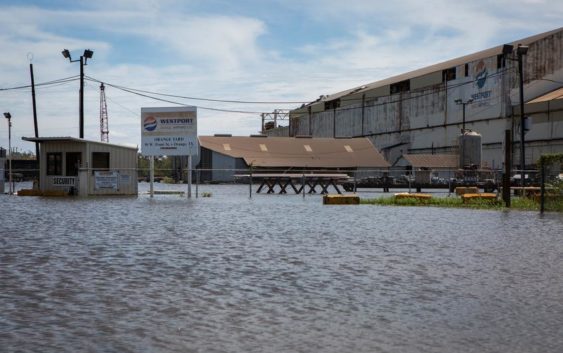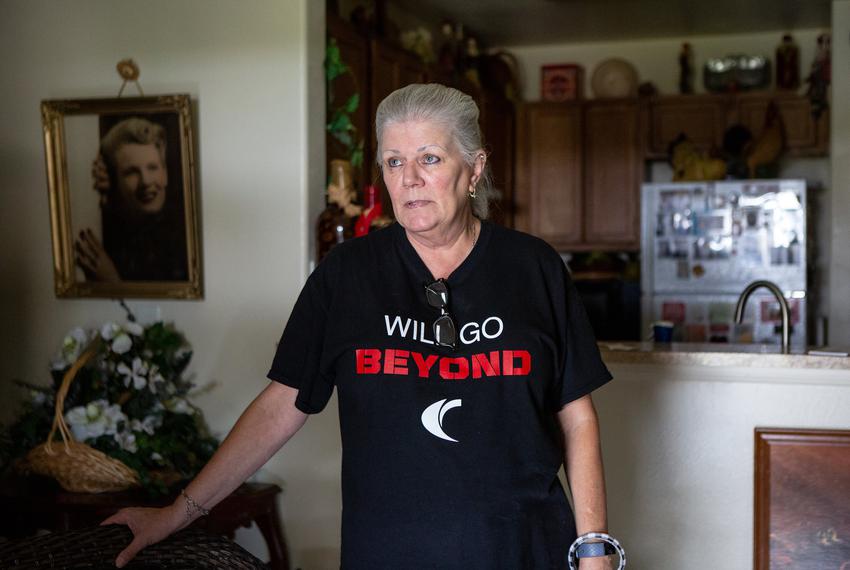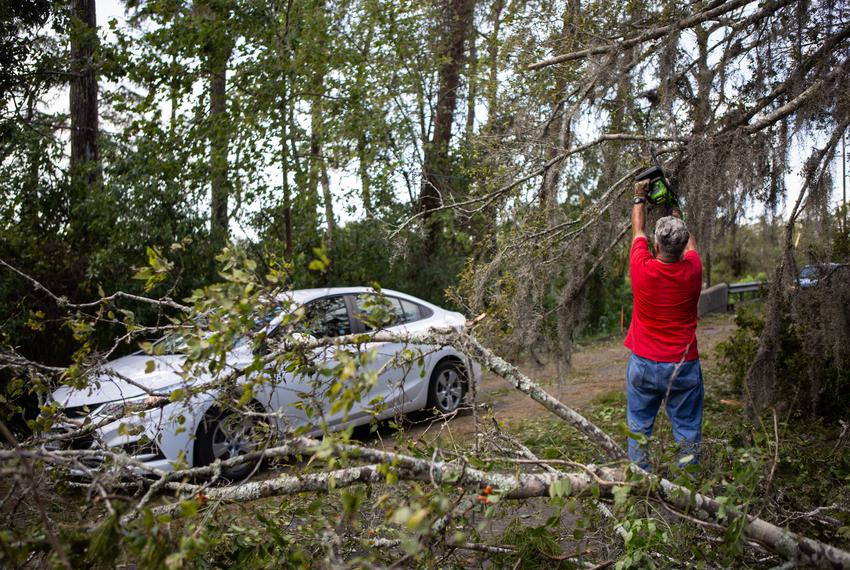- Sellers and Rantanen are among the NHL trade deadline winners. Hurricanes and Boeser are some losers
- Hurricane forecasters express concern over NOAA job cuts impact
- FEMA deadline for Hurricane Helene recovery aid extended again
- Tornado drills to take place at schools across North Carolina Friday morning
- Hays County emergency alerts cause confusion during Tuesday's wildfires
Hurricane after hurricane wreaked havoc in Orange, Texas. Finally, residents say they got a break.

ORANGE — Robert Walker planned to ride out Hurricane Laura, just as he had with most other big storms that over the years have repeatedly pummeled this region of refineries on the banks of the Sabine River bordering Louisiana.
As a drainage foreman for the city, he is responsible for clearing floodwater from streets and is considered key — particularly with Laura’s initial predicted storm surge of at least 10 feet.
But late Wednesday afternoon, as projections for the powerful hurricane’s impact on Orange worsened, Walker’s boss urged him to leave. The 61-year-old corralled his five cats and joined his wife in a friend’s cabin outside of Lufkin. On Thursday, he pulled up outside his house in Orange’s historic district and marveled at what he saw.
“I really expected the roof to be torn off,” he said. “I dodged a bullet.”
That phrase was echoed verbatim across Southeast Texas on Thursday as state and local leaders and thousands of residents surveyed the comparatively little damage with gratitude — and surprise. Although Orange was the worst-hit area in Texas, just 40 miles east, residents of Lake Charles faced significantly more severe and widespread destruction. Authorities said at least four people in Louisiana died because of the storm.
Gov. Greg Abbott, who visited Orange on Thursday and conducted an aerial tour, said the area had been remarkably fortunate. The city of about 18,500 people is the county seat of a region whose economy revolves around its many chemical plants and had been directly in the hurricane’s sight, with forecasters predicting “unsurvivable” storm surge as it strengthened into a Category 4 storm Wednesday. It turned slightly east early Thursday, landing 70 miles from Orange in Cameron, Louisiana, before weakening into a tropical storm as it headed north.
“There is a collective sigh of relief across the county,” Orange County Judge John Gothia said. “Finally, we’re getting a little bit of a break. We have been in the eye of so many storms.”

The Westport Orange Shipyard stands in floodwater from a swollen Sabine River in Orange. Credit: Pu Ying Huang for The Texas Tribune
Residents list them with the familiarity of relatives: There was Rita in 2005, Humberto in 2007, Gustav in 2008, Ike in 2008 and Harvey in 2017. Last year, Tropical Storm Imelda battered the region again, flooding for a second time the homes of many who had suffered during Harvey.
“It’s like we can’t catch a break,” said Maureen McAllister, president of the United Way of Orange County.
Sandy Simpson, a 64-year-old employee at Home Depot, was born and raised in Orange and said she slept through most of its hurricanes — except for Rita, when she evacuated.
“I was going to ride this one out, too,” she said. “But then it kept growing from a Category 2 to 3 to 4, and they were saying this ‘unsurvivable’ surge — if that had happened, we would have been gone.”
She and her son drove to Katy, just outside of Houston, on Wednesday and rented a hotel room for the night before she returned to Orange on Thursday morning.
“It’s almost just like I left it,” she said as she walked into her apartment. “I don’t think you ever get prepared for these storms. You just never know what you’re going to wake up to.”


Sandy Simpson, 64, was relieved to find her home in Orange relatively undamaged after she evacuated to the greater Houston area ahead of Hurricane Laura. Credit: Pu Ying Huang for The Texas Tribune
Across the county, which has a median household income of about $55,700 for its 83,400 residents, most who identify as white, the damage was less than anticipated — but still grave enough. Powerful wind gusts uprooted trees, ripped roofs off houses — flinging them feet away in the shape of twisted napkins — and shuttered electricity to two-thirds of Orange County. No deaths or injuries had been reported there late Thursday, with county leaders crediting their own planning and residents for mostly heeding their mandatory evacuation order.
“That was key for us,” said Gothia, the county executive. “We hardly had to do any rescues. … I hope if and when we have another storm that people continue to heed the warnings.”
Floodwaters, fallen trees and downed power lines made parts of the county impassable, with damage most severe inside Orange’s city limits, Gothia said. Most houses there had been abandoned, some carefully boarded up, as their owners fled.
In West Orange, Robert Sepulvado was clearing an enormous tree from the road. The 69-year-old retired chemical plant worker lives in a mobile home, so he drove to Houston on Wednesday to stay with a friend.
“Every time I read about the hurricane, it was doubling in size,” he said.
He considered Orange’s sudden stroke of fortune and the timing of it all — one of the most powerful hurricanes to strike the Gulf Coast in decades and during a coronavirus pandemic that has claimed tens of thousands of lives — as a message from God.
“Some people call it luck and some people call it God,” Sepulvado said. “It’s a warning for us to straighten up.”


Robert Sepulvado clears debris caused by Hurricane Laura. Credit: Pu Ying Huang for The Texas Tribune
Todd Thomas, a 47-year-old engineer, drove his 73-year-old mother to his sister in Beaumont. He returned Thursday to inspect the damage on their century-old family home. He thought that it resembled the havoc caused by Hurricane Rita in 2005. Around him, trees had crashed through homes and onto ceilings.
“We got lucky,” Thomas said. “It’s a very sturdy house.”
Mack Toler Jr., an amputee who lives near the Sabine River in east Orange, stayed throughout the storm — not able or willing, he said, to leave with his wheelchair.
“That wind was something,” the 71-year-old said. “It sounded like a train was coming.”
A few blocks away, Jesse Burrell inspected the chaos Laura unfurled on the Mount Calvary Baptist Church he attends. The wind ripped off its white steeple, tossing it several feet away, and across the street unrooted a tree, forcing it onto a house.
“This is kind of a mess,” Burrell said. “You can tell there was a lot of wind.”
Burrell went to stay with family in Humble, but he said the process of evacuating during a pandemic is a “headache.”
First: Jesse Burrell points to the top of Mount Calvary Baptist Church, where the building steeple blew away into the debris pile behind him. Last: Mount Calvary Baptist Church’s steeple lies entangled with debris from trees on the ground. Credit: Pu Ying Huang for The Texas Tribune
“Now with the virus, it’s just a lot more complicated,” he said. “Everything is complicated. You can’t just put people on the bus to evacuate them as you used to. You can’t pile them up in a church or gym and put them in cots. Everything is much more difficult.”
Walker, the drainage foreman, clasped his hands together in grateful prayer as he trudged around his home.
He bought it in 2006, only to see it flood completely in 2008 during Ike. He recently spent another $13,000 remodeling it.
“Thank the Lord,” he said. “I would have been crying like a baby if it was torn up again.”
First: Damaged buildings, broken tree limbs and loose debris appeared all over town after hurricane-strength winds blew through Orange. Second: Westport Orange Shipyard stands in floodwater from a swollen Sabine River. Last: A broken traffic light hangs in the street. Credit: Pu Ying Huang for The Texas Tribune
This time he and many of his neighbors had been spared, while western Louisiana had been pounded — yet again.
Walker said the relentless cycle had begun to weigh on him. When he retires in four years, he plans to head north.
“I want to go to a place where the water runs downhill,” he said. “There’s just too many hurricanes around here.”
Correction: An earlier version of this story used an incorrect first name for Robert Sepulvado.